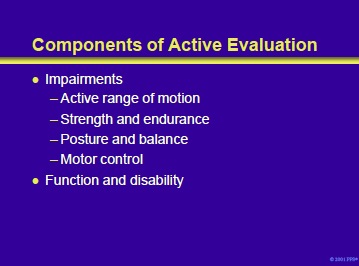Page 14 of 26

Components of active evaluation include impairment, function and disability.
Methods to measure impairments include the following:
- Range of motion can be assessed by adding an active component to the passive motion exam and measure range with a goniometer or with a 3-D kinematic gait analysis to quantify motion during gait and other tasks.
- Strength and endurance can be evaluated through posture and motion, fatigability, functional tests, isometric or isokinetic dynamometry, oxygen or heart rate, or instrumented activity monitoring (eg, step activity monitor).
- Posture and balance can be assessed by direct observation of static and dynamic posture, specific tests or protocols, kinematic record of static posture, indicators from gait such as limb support times and step width, or force plate (sway) and instrumented balance systems.
- Motor control can be evaluated by observing isolated movements without gravity and with adjacent joints in flexion and extension; observing intralimb and interlimb patterns; kinematic analyses of active motion under different conditions and EMG analyses of muscle activation during tasks.
Add comment